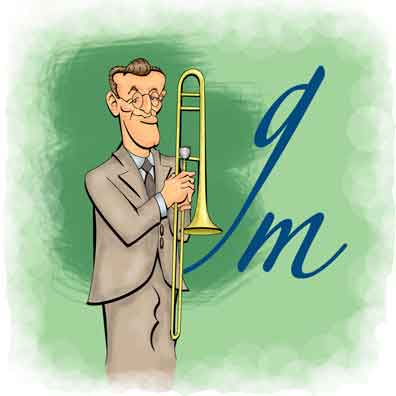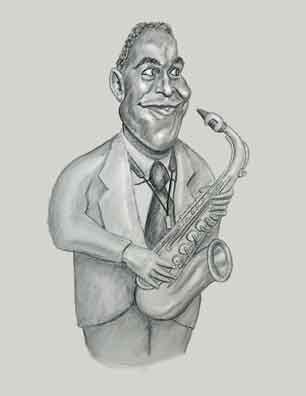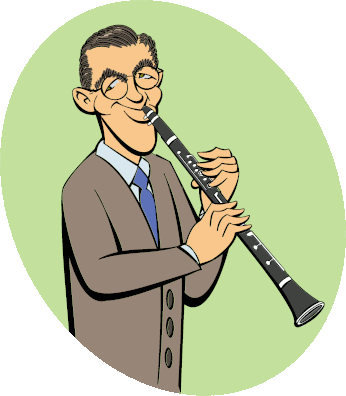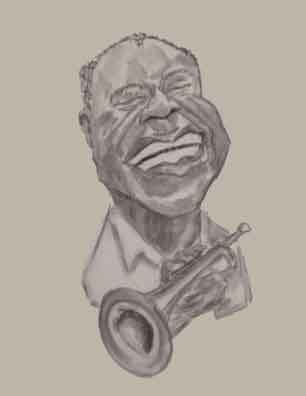Jack Teagarden
The Original Mr. T1

(Click to Zoom In and Out)
Weldon Leo Teagarden - "Jack" to his many friends2 - is considered one of the best jazz trombonists and jazz singers in the history of the art. The odd thing about Jack's music - instrumental or vocal - is he never really tried to be flashy or impress anyone. He just played and sang and that was good enough.
Footnote
One of the oldest sources states that Jack's real name was John Weldon Teagarden. But in this source there is no source for the source and almost every other source says his given names were Weldon Leo.
Support for the Weldon Leo sans John name is a copy of the 1920 census. The kids in the family are listed as Norma, Charles, Clois, and "Weldon L". No John or Jack mentioned.
It wasn't just impressing the - quote - "layman" - unquote. One of those impressed was fellow trombonist Glenn Miller. He and Jack performed with the famous Ben Pollack in the 1920's and by one account Glenn thought Jack was so good that he pared back his own solos. Glenn's hiatus soli wasn't just a momentary glitch since you almost never see a film of him ripping off a hot solo.3
Footnote
One place you do see Glenn - quote - "ripping off a solo" - unquote - is in the movie Orchestra Wives. Actually, this - quote - "solo" - unquote - was nothing more than a riff and it appears the notes were added in post-production. Of course, there are some trombone solos on Glenn's recordings but you can't tell if they're him or - as we guess - one of his own trombone players.

Glenn
Hiatus soli.
Jack was born in 1905 in the small town of Vernon, Texas.4 Like most jazz musicians of the early 20th Century, he received little formal training - the University of North Texas didn't have it's jazz studies program set up then. Instead he learned music from his parents. His dad, Charles, played trumpet (actually cornet) when he wasn't working in the oilfields, and his mom, Helen, was a piano teacher and a church organist.
Footnote
For those not familiar with the Texas geography, Vernon is about five miles northeast of Lockett, sixteen miles southeast of Odell, and thirty-five miles north of Mabelle.
Like another jazz great Charlie Parker, Jack's first instrument was the baritone horn (the smaller cousin to the euphonium). But he switched to trombone when he was about seven. Helen also taught Jack the piano and she also played professionally in the silent movie theaters. Jack, who had absolute - ergo, "perfect" - pitch, soon became good enough to join her. The three other siblings, Norma, Charlie, and Colis, also became professional musicians.

Charle Parker
Another Jazz Great
Charles died in 1918 and the family moved to Nebraska to Oklahoma and later back to Texas. Although money was tight, the Teagardens kept playing music.
Fortunately the music did provide some income The early 20th century was a time when everyone danced. No matter how small, all towns had their dance halls. Although not completely passée, the era of these institutions of varying size and respectability faded out in the 1950's. Electrical sound systems were rare and by necessity the music was live. So in 1921 and only sixteen years old, Jack found work playing in bands in San Antonio and then around Houston.
Jack's first real work was in a band led by pianist John "Peck" Kelly, and it was while Jack was playing for Peck that Paul Whiteman, at that time the biggest name in popular music, heard him play. Paul offered the young man a job, but Jack preferred to remain in Texas.5
Footnote
Peck also turned down an offer from Paul, and other big name band leaders were never able to woo him from the Galveston-Houston area. He said that if he had joined a big name band it would leave him no time to play his own music.
But eventually the lure of the Big Apple was too strong. Five years later, in 1926, Jack left Texas to join the touring band of Doc Ross's Jazz Bandits.6 Then the next year he relocated to New York.
Footnote
Jack's mom, by the way, largely remained in the Texas-Oklahoma region and kept making music for decades. There's a photo of her standing before by a microphone of the iconic Oklahoma City station, Yours Truly KAY-OH-EM-AAYEEE!
By now Jack was good enough to play for virtually any band, and he found work with Ben Pollack (who also employed a young upcoming clarinetist Benny Goodman). Along the line Jack had also established himself as a strong vocalist, particularly on blues and ballads. In the ensuing years he continued to play in a number of bands and that did include Paul Whiteman's. In fact, Jack stayed with Paul for five years until he left in 1938 to start up his own group.

A Young Clarinetist
It seems a bit odd that a young man with firm Southwestern roots would take to New York as a second home. But of course opportunities there were far better there for a skilled musician. New York was also a good venue to pick up extra cash playing at rent parties. Rent parties were gatherings where residents of a house or an apartment would invite some people over. Naturally there would be dancing and so the presence of a band was a necessity. The guests would chip in a certain fee, a portion going to the host to pay the monthly rent (hence the name) and the rest would go to the musicians.
Saxophonist Coleman Hawkins remembered that Jack would go to the rent parties in Harlem and play all night. We suspect this was less for the money than for the opportunity to play and sing with the top-flight African American musicians. Jack's style had been heavily influenced by the blues that he had first heard in Texas. Although growing up in an area and time of strict segregation, Jack had learned a lot of his music from his black neighbors. He grew up thinking everyone should be colorblind and he carried this philosophy with him throughout his life.
Jack didn't just perform for live audiences, and from 1929 to 1961 he made over 200 recordings. Sometimes the records were not by any given band but simply a group of musicians that the studio hired to cut the platter (once such studio group, "The Charlton Chasers", included not only Jack and brother Charlie, but Glenn Miller, Benny Goodman, and Jimmy Dorsey). In addition to playing with Ben Pollack and Paul Whiteman, Jack also recorded with Eddie Condon, Red McKenzie and Jack Bland, Fats Waller, Hoagy Carmichael, Allan Holt, Paul Mills, Benny Goodman, Red Nichols, Johnny Mercer, Teddy Grace, Sophie Tucker, Bing Crosby, and (of course) Louis Armstrong.

Louis
He and Jack played together.
Jack in fact joined Louie's group in late 1940's, and a film of them singing the Hoagy Carmichael composition "Old Rocking Chair Got Me" was one of the most popular sequences from the Ken Burns Jazz miniseries. If nothing else the clip introduced Jack to the latter 20th century public.
During his career Jack made a number of movies, many of them short subjects, and in one he even sang "Old Rocking Chair" with Hoagy Carmichael himself. Of course, starting with the 1950's Jack also appeared on a number of television shows, including an early Tonight Show episode with Johnny Carson.
One advantage of his being self taught is Jack was able to develop his own playing mechanics. The trombone has seven slide positions and it's often a challenge for youngsters to make the farthest stretches. Without anyone to tell him that he just needed to keep practicing until he got bigger, Jack adapted his playing to where he didn't need to reach beyond the fourth position which is only a bit more than 3 inches past the bell. Naturally to play real tunes he had to use the upper registers where overtone notes are closer together.7
Footnote
Without going into precise mathematical definitions, overtones - or more accurately a harmonic series - are notes that are produced on a musical instrument using a single fingering or (in the case of a trombone) slide position. For instance, in the first position - the slide is as close to the mouthpiece as possible - the "real" notes that can be played in classical trombone pedagogy are B♭1 (contra or "pedal tone" B♭), B♭2, F3, B♭3, D4, F4, A♭4 (out of tune - very flat), B♭4.
The next note in the first position is high C (C5, ) and so after the high B-flat (B♭4,
), no notes are more than a step apart. In principle above high B-flat a lot of tunes could be played in the first position.
Before the 20th century, the uppermost note expected of even virtuoso players was in fact this high B-flat (B♭4). In 1878 in Kronstadt, Russia, Nikolai Rimsky-Korsakov premiered his highly popular but (let's admit it) overrated Concerto for Trombone and Wind Orchetra (Концерт для тромбона с Духовым оркестром / Kontsert dlya trombona s Dukhovym orkestrom). Although in the cadenzas some modern editions go up to high-high F () the original score has no note above the traditional "high" B-flat four lines above the staff.
Of course even then many players could go above that and when Maurice Ravel wrote Bolero in 1928, the trombone soloist starts off on the high B♭ and moves up to a high D-flat (D♭5, ). What makes this solo particularly difficult is the player has to sit quiet through half the tune - about 7 minutes - and then hit the notes "cold". Today it's not unusual to hear even first class symphonic players flub the part.
One particular unsung high noter was Jerry Hyman, who played trombone for the second incarnation of Blood, Sweat, and Tears. At one point during the trombone solo of "God Bless the Child" - which was cut from the single release - Jerry hits a high-high F (F5, ) and seemingly with little effort.
By reducing the slide movement Jack could play lots of notes even in tunes with moderate tempos (not unlike the Adagio in Joaquin Rodrigo's Concierto de Aranjuez). To the layman Jack's playing is simple and sounds easy but the cognoscenti tromboni will recognize the challenges.
Knowing that the aspiring jazz bonists might struggle with his playing style, Jack wrote an 8-page book on how to reach to the upper registers. He started off with warm-up passages and then had exercises that led to progressively higher notes. The last exercise went up to the high-high D ( ).8
Footnote
That's D5 and Jack could easily exceed this range. On one recording of "St. James Infirmary", he hits E5 ( ).
Jack led his own band from 1939 until 1947, and he would sometimes draw on his family to fill the spots. His brother, Charlie, was an expert trumpet player and had also played with the likes of Paul Whiteman and Tommy Dorsey. For piano players Jack would recruit his sister, Norma, and his mom, Helen. Neither was any slouch and Norma had also played with Ben Pollock and in later life performed regularly in the San Francisco area.
Living an itinerant life can be hard on a family and Jack was married four times. His last wife, Adeline Gault, was an aviator which may have helped as Jack did travel an awful lot. It's sometimes not appreciated how hectic a tour can be. Jack might play in New York one night, then head to Chicago for another. He might even appear at the Kennewick Grape Festival in Washington.9 Norma remembered that touring with Jack was somewhat hectic, and she might have to sleep on their luggage rather than a bed. Extending performances beyond a single night was rare. Two-nighters were luxuries.
Footnote
Such eclectic stops are not uncommon even for top celebrities. Once Doc Severinsen appeared at the Cincinnati Zoo. "Someone's gotta play for those animals," he explained.
Despite Jack's fame and the respect in which other players held him, he never had great commercial success. One scholar said that he didn't have any real business sense and he did like to party. He was also generous and paid his own players higher scale than other band leaders.
But perhaps Jack's biggest difficulty in reaching the Great  Public was his music was so laid back. It didn't sound flashy. What he played was largely blues, and so his songs weren't something you could cut the rug to. Nor in later years did he switch to be-bop, a style that among its other virtues helped reduce jazz to less than 1% of total music sales. But sticking with his own style had its advantages. In 1958 Jack was invited to join the good will entourage that was organized by the State Department to tour the Far East. With this recognition, Jack felt that all the years of hard work had finally paid off.
Public was his music was so laid back. It didn't sound flashy. What he played was largely blues, and so his songs weren't something you could cut the rug to. Nor in later years did he switch to be-bop, a style that among its other virtues helped reduce jazz to less than 1% of total music sales. But sticking with his own style had its advantages. In 1958 Jack was invited to join the good will entourage that was organized by the State Department to tour the Far East. With this recognition, Jack felt that all the years of hard work had finally paid off.
Charlie, Norma, and Helen lived long musical lives. Sadly Jack did not. By the early 1960's Jack was not in the best of health and had suffered bouts of pneumonia. In December 1963, he was booked to play the Dream Room in New Orleans's French Quarter. But by the New Year, he had become so ill that he had to perform sitting down. On January 14, he went to a hospital and the doctors recommended immediate hospitalization. But Jack decided to just return to his motel room. The next day the maid came in to clean the room and found Jack was dead. He was 58.
References and Further Reading
"Jack Teagarden, The First Great Jazz Trombonist", David Guion, Musicology for Everyone.
"Jack Teagarden", Ren´ Laanen, Trombone Page of the World.
"Jack Teagarden", Christopher Popa, Big Band Library, February 2006.
"Jack Teagarden", Biography.
"Jack Teagrden", Encyclopedia.com.
"Jack Teagrden", Encyclopedia Britannica.
"Teagarden, Weldon Leo [Jack] (1905–1964)", Charles Davis, Handbook of Texas Online, Texas State Historical Society.
"A Short Teagarden Genealogy", Joel Hartley, jmhartley.com, September 6, 2019.
"Kelley, John Dickson [Peck] (1898–1980)", Martin Kohout, Handbook of Texas Online, Texas State Historical Society.
"Jack Teagarden", Discography of American Historical Recordings, University of California - Santa Barbara.
"Jack Teagarden", Discogs.
"Jack Teagarden - Jazz Trombonist and Vocalist", The New York Times, January 16, 1964.
"Jack Teagarden", Find-a-Grave, December 7, 1999.
"Norma Teagarden", Find-a-Grave, November 30, 2009.
High Tone Studies for Trombone, Jack Teagarden (Author), David Gornston (Publisher), 8 pages, 1936.
"The Chicken or the Egg: Why Did Jazz Lose its Popularity?", Karen Helseth, Washington University Center for the Humanities, July 11, 2011.
"When jazz Stopped Being Cool", John Blake, CNN, September 26, 2016.
"Is Jazz Dead?", Yale Daily News, Ethan Dodd, April 11, 2019.
"Adeline Teagarden, Pioneer Woman Pilot", Sun Sentinel, February 16, 1997.
"Kennewick Grape Festival", The Kennewick Courier-Reporter, September 19, 1946.
"Jack Teagarden", Internet Movie Data Base.
Jazz, Ken Burns (Producer and Director), Lynn Novick (Producer), Geoffrey Ward (Writer), PBS, 2001, Internet Movie Data Base.
The Tonight Show with Johnny Carson, Johnny Carson (Host), Skitch Henderson (Band Leader), Ed McMahon (Announcer), James Stewart (Guest), Phyllis Diller (Guest), Ed Wynn (Guest), Ann Vivian (Guest), Jack Teagarden (Guest), NBC, November 11, 1963.Internet Movie Data Base.